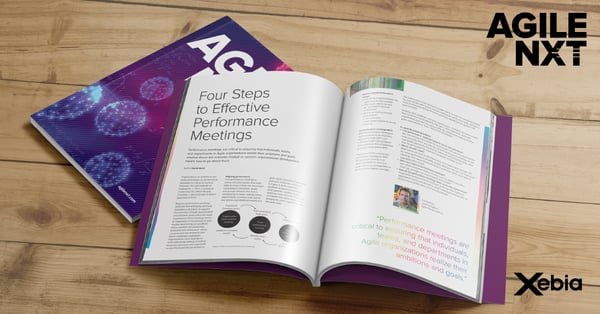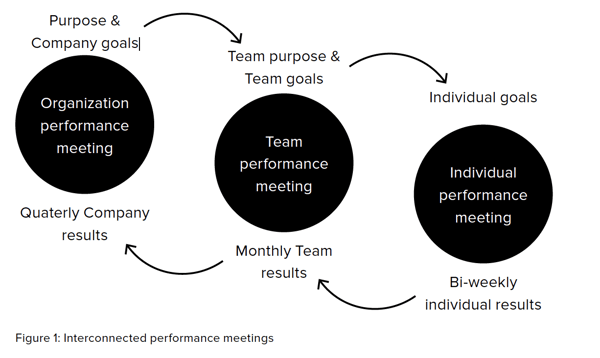Performance meetings are critical to ensuring that individuals, teams, and departments in Agile organizations realize their ambitions and goals, whether these are outcome-related or concern organizational development. Here’s how to go about them.
Organizations set ambitions and goals at all levels, so performance execution is critical to success. However, the vast majority of employees — 71% in a survey by Leadership IQ, a Mark Murphy company — are uncertain of what’s expected of them.
This article is published in  . Agile NXT is the magazine full of inspiration for professionals on the emerging Agile journey. Theme of #2: New Insights for Agile Performance Management.
. Agile NXT is the magazine full of inspiration for professionals on the emerging Agile journey. Theme of #2: New Insights for Agile Performance Management.

Regular performance meetings eliminate that ambiguity and help assemble a structure to support the execution of both development and outcome goals within the Agile organization. Such meetings serve as waypoints on the journey to end results, functioning as a platform where updates are presented, evaluated and celebrated, where consensuses are arrived at and future roadmaps negotiated. Organizations can’t operate or scale effectively without meetings ensuring autonomy and alignment across the board for performance.
Aligning performance
For performance meetings to deliver the best results, they must align to cover a three-tier framework consisting of individuals, teams and groups of teams that form a company (or in larger settings tribes, departments, business units and so on), where organizational targets and goals ripple outwards to each team and each contributor, as we see in Figure 2. At the same time, feedback at each level must flow back upwards, creating multiple response loops that help individuals recalibrate their performance while bringing the entire organization onto the same page.

Taken together, performance meetings allow teams to work towards development and outcome goals simultaneously, rather than risk quality attrition as often happens when the processes are managed separately.
Each team member must have an individual performance meeting every two weeks with an executive in a leadership role (such as a chapter lead or team manager) who carries formal co-responsibility for professional growth, to assess their progress towards both goal types. This frequency creates a broad picture of individuals’ contribution and development ahead of the team performance meeting and maintains feedback loops across the organization.

The time costs involved can be a cause of concern, but these are reduced as the process becomes more efficient. In addition, individual performance meetings can be delegated – but they cannot be eliminated, as individuals perform best when they are taken care of.
Leaving room for autonomy
There are some fundamental principles to keep in mind for people leading performance meetings.
1. It’s not about you
Performance meetings aim to maximize productivity, so they must necessarily focus on the person or people across the table. Your job as the meeting’s leader is to determine what people need to achieve success. A practical suggestion here is to maintain an open mind and focus on a constructive outcome. Spend a few minutes preparing for each meeting and only bring facts to the table.
2. Close the loop
At the start of each meeting, look back at previous deliverables and evaluate whether the actions were executed and to what effect. A good tool to close the feedback loop is Deming’s cycle of Plan, Do, Study, Act.1

Figure 1: PDSA – cycle
3. Achievable next steps
End each meeting by formulating achievable actions for next time. These must typically lie within the individuals’ stretch and bring them closer to their goals. Avoid operational tasks or the meeting will degenerate into a reporting session. Seek to operate from the delta level instead and discuss what people would like to change, how they expect to create that change and what its effects would be.
Steer clear of a lengthy or recurring list of action points. Should you encounter these, respond by focusing on executing fewer items per person over each period.
4. Ask open questions
It might feel straightforward to ask open questions in performance meetings, but this can be challenging in practice as people often tend to leap at solutions without a sharply defined image of the problem they are trying to solve. A practical tip is to formulate questions in line with predetermined goals. A good baseline of questions, as shown below, allows you to easily elaborate and drill down with more open questions if needed.
Baseline Agenda Performance dialogue
- How did we progress towards our goals since our last meeting?
- What do you want to do over the next period to improve performance?
- What do we need to succeed going forward?
- From each other
- From people outside our group
- From me
Are performance meetings NXT?
Effective performance meetings in Agile organizations are important, but are they really NXT? Lean enthusiasts might even recognize these guidelines from a Toyota Kata technique dating back to 1975!
The truth is that the concept of a performance meeting isn’t NXT, but applying it correctly in an Agile organization is. You can’t expect autonomy and alignment on performance to happen overnight. You have to put in the work and create habits in order to consistently (re)align the end results with teams and the individuals within them while also leaving room to stimulate and grow self-organizing capabilities for performance improvement.
Nobody likes meetings, but when performance meetings are done correctly, they reconnect the leadership with teams and individuals across the organization and offer the opportunity for realignment towards common goals and ambitions. That makes it all worthwhile.
Frequently asked questions
- Can performance meetings replace scrum retrospectives
- Where should I start?
Most teams are used to retrospectives, so it makes sense to begin with the team performance meeting, before adding in the role and value stream meetings. The value stream meeting in particular needs to be timed to aggregate team inputs.
- How can I improve performance meetings?
Add a flash evaluation before closing, such as asking a question:“How can we make our next meeting even better?”
- How do the performance meetings differ across the various levels?
Organizational/departmental and team meetings differ mainly on aggregation levels and attendees, while individual meetings differ on timing and resemble more of a coaching session.
Want to know more about this topic? Download  Agile nxt magazine-new-insights-for-effective-agile-performance-mng and start your personal change tomorrow. And join us for the Future Friday, the 1 day hands-on conference to inspire you to set the next step in Agile.
Agile nxt magazine-new-insights-for-effective-agile-performance-mng and start your personal change tomorrow. And join us for the Future Friday, the 1 day hands-on conference to inspire you to set the next step in Agile.






